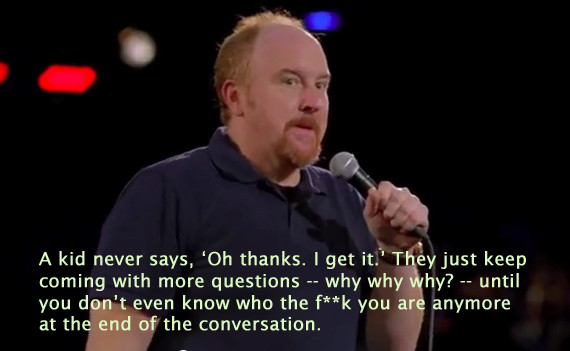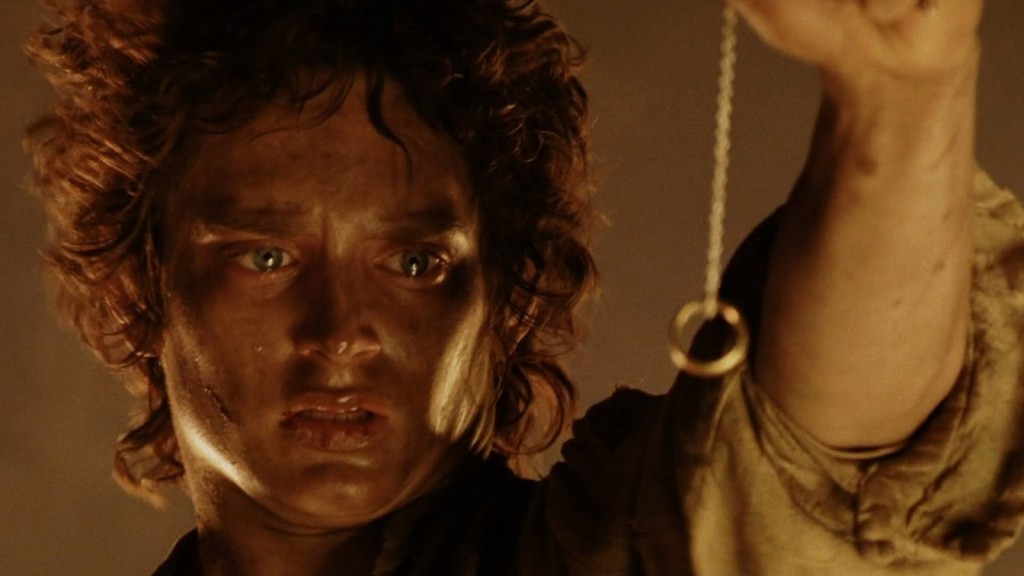Understanding Why
Part 2 in a series on narrative design. Previously, I introduced the idea of why layers: always ask why something is happening, and provide as many answers as you can. But how about the viewer? Why should they care about why things happen?


Earlier, I wrote about why layers. The basic idea is that as you develop a story, you should always be asking yourself "why is this happening," and the more "why" questions you can answer, the more fleshed out the story becomes. But through it all, I seem to have forgotten my own rule.
Why are why layers important? Why do we care about finding out why things happen? Why do we ask why?
It's a funny question, but it's one that builds from the core of what narrative really means and why we engage with it. Even though it gets kind of weird, we still have to figure it out. But once we do, we can find many ways to use why layers and develop better stories.
But first, let's start off with a joke.
Contextualizing The Little Moments
A man was walking along a beach in California when he found a genie in a bottle. The genie said "Okay, you know how this works, but I'm only going to give you one wish, so choose wisely."
The man thought for a moment. "I have a vacation home in Hawaii, but I hate flying there. It makes me sick and nauseous. I'd like to have a bridge that connects California to Hawaii."
"Are you insane?" the genie asked incredulously. "A bridge? How do you expect that to work? I'm supposed to lay concrete down all the way to the bottom of the ocean floor? Ridiculous. Give me something a little more realistic to work with."
"Hmm," the man sighed. "Alright. How about instead of the bridge, you tell me how women's minds work?"
"You want two lanes or four?" asked the genie.
Pretty standard joke. You've probably heard it before. Let's apply why layers to it. Why does the genie refuse to teach the guy how women's minds work? Because it's impossible. It's even more impossible than building a bridge from California to Hawaii (which has been established to be quite impossible). That's what makes the joke funny.
Now, let's try changing the punchline a little bit.
"Hmm," the man sighed. "Alright. How about instead of the bridge, you tell me how women's minds work?"
"Understanding a woman's mind is probably more difficult," the genie replied. "How about I'll just build you the bridge instead?"
Well... it's not funny anymore. Even though it says the exact same thing, it's not funny anymore.
The why layers aren't the point. Just because they exist doesn't automatically mean that they are interesting. Both versions of the bridge joke have the same why layers, but one of them isn't even a joke anymore.
Why layers are interesting when the reader figures them out on their own. The reader has to figure out the connections and the reasons by themselves. When it works well, everything just clicks into place and the story makes sense. Every event has a cause and an effect, and you can trace them back to their roots. Suddenly, the story becomes nuanced and multifaceted, with multiple lines of thought trailing through different causal relationships. You become attached to the characters, because you stuck together with them and you know why they did the things they did.
The reader's involvement is crucial to this process. If the reader does not actively try to dig into the why layers, then the narrative becomes meaningless. Even if the story is filled with rich backgrounds and context, none of it reaches the reader. As writers, we should make sure that the stories we create have a good amount of why layer depth, but we must not forget that the reader is just as important to the process.
It's important for the why layers to be there, but we can't present them all at once. If we just shove everything into the reader's face, it's not a story anymore, it's a history textbook. There's just way too much information to handle. That's why great stories will slowly reveal the reasons why characters do the things they do. Great stories use careful pacing to make sure readers can follow the story without being overloaded by all the context.
A story's climax is a great place to pull all the why layers together. At this point, the reader can make the tentative dive into the why layers you've prepared for them. All of the story's plotlines converge into a single point, and the final clash shows you why everyone did what they did.

Take the climax of Lord of the Rings. Frodo stands at the edge of Mount Doom, hesitating before throwing the One Ring into the fires. Sam yells and pleads with Frodo to let go of the ring and let it fall. Suddenly, Gollum shows up and wrestles with Frodo for the ring. Their scuffle ends up in Gollum biting Frodo's ring finger off and falling into the fires himself. Ultimately, the ring is destroyed along with Gollum.
This scene is just filled with plotlines and causal events that are just so fun to tumble around in your head. Suddenly, we see the reason why Gollum exists. He is the final factor that destroys the ring. Why was Gollum there? Because the hobbits allowed him to come along with them out of goodwill. People have tried to destroy the ring before, and they never succeeded. Elrond and Isildur stood upon the exact same edge that Frodo and Sam did. The reason why they didn't succeed was because Gollum wasn't there.
And do you think that they, a mortal man and a proud elf, would have tolerated Gollum's presence on their way to Mount Doom? No way. They would have spurned Gollum as the disgusting, filthy creature that he is. But the hobbits, filled with goodness and kindness and innocence, brought Gollum with them. If they hadn't, history would have repeated itself. Frodo would have escaped with the Ring, Sam would have been helpless to do anything, and after hundreds of years Sauron would reform again.
So why did the story happen the way it did? Because hobbits hold a level of purity that no other race does. Hobbits are silly and rowdy and lazy. They play all day without a care in the world. But it is precisely because of those traits that they were the only characters in Middle Earth who were capable of destroying the ring. All the grimdark humans and the zealous elves and the brutish orcs took their lives so seriously, but that itself was their downfall. The hobbits were simple, and you could see how simple they were because you followed their journey with the Fellowship. While everyone else is gritty and hardboiled and ready to save the world, the hobbits are dancing in pubs and eating two breakfasts. It makes sense. We see why it happened.
You can also see that Tolkien was careful to keep these why layers hidden until the final climax. Throughout the whole story, we're wondering why these stupid little hobbits are taking the ring. Why not give it to a human? Boromir's plotline shows us why, but it doesn't give us the whole story. Or why don't the hobbits just ride a flying eagle to Mount Doom? Or why don't they use a massive catapult to launch the ring into the fires? Or why don't the humans just get a massive army together and crush Sauron's empire and not even bother with the ring at all?
We only see the answer at Gollum's climax. The ring can only be destroyed by a pure-hearted ideology. You can't crush the ring, you can't smash it with brute force. Tolkien wants us to know that the answer is not to fight and wage war and flaunt power. His answer is to go back to the roots and be simple-minded, loving people who enjoy life. To destroy the ring, you have to seek peace, not war.
Do you see how much context we can get from a little imp-thing biting off someone's finger? How that one small action can reveal so many why layers underneath? If you showed LotR's climax to a completely new viewer, it would make absolutely no sense. But if you've followed Frodo's and Sam's journey through the whole ordeal, everything comes together. The joy comes from tumbling the scenario around in your head, letting all the pieces show what the story's really all about.
This is what why layers are for: they contextualize the little moments. A story becomes great when it presents a scenario that makes no sense in isolation, but through the why layers we see the context and understand why it happened, and that it couldn't have happened any other way. That's how stories get people to think, and analyze, and learn.
Climaxes aren't the only way to do this. All the little moments leading up to a story can have context. When Cobb spins his top in Inception, it has meaning. We don't understand the meaning at first, but through the rest of the movie, the top becomes so significant that it becomes the ending shot. Or when the Joker talks about his scars in The Dark Knight, we know that he's talking about more than events: he's telling us about his personality and why he's such a crazy guy.
A character's idiosyncrasies are actually a great way to tell us more about that character and why they do the things they do. In Burning Tides: The Reckoning, we see that the character Twisted Fate is scared of water. He doesn't outright tell us that he's scared of water, but we see it in the small things he does: he comments about how he needs new clothes to replace the sea's stink, and we also see how he opts to choose paths around water whenever available. So why does he hate water so much? Well, there's an answer for that too, and it turns out that the answer plays a pretty big part in the story's climax. But just the fact that we can think "oh, Twisted Fate hates water" is a small satisfaction in and of itself. It makes us think that we've grown to understand the character a little better.
It's a magical moment when you understand a character so well that you can predict what they're going to do. When it happens, it feels like there's an actual bond, that you have a connection with the character, that you know how they think. That feeling is one of the reasons why we make friends at all: because we crave those little moments when we think we understand each other.
Why does the doll in Sebastian's Voodoo stab his hand first? Because it's wrestling with two conflicting problems: it wants to save its friend, but it also doesn't want to die. The doll could have just stabbed itself through the heart from the very beginning, but it was scared. It wanted to see if there was a way to get the best of both worlds, to save its friend and still live at the same time. All of the tension in this short animation comes from the duality between those two problems, and the slow eventual realization that a sacrifice must be made.
Why does Ekko restore the mural in Seconds? Because it means a lot to him. We don't know what it means, but we do know that it's very, very important. The whole animation sets up his time machine's mechanics very well, so we can see that it's going to be extremely painful for him to restore the mural. But he still does it. That small realization generates so much curiosity. Just what is so special about the mural?
Why does Gordon Ramsay start every single dish with olive oil? Because he loves olive oil. I don't think I've ever seen any of his Youtube cooking videos without olive oil in it. It's kind of surreal. He uses it in everything. He would use olive oil if he was making cereal. Maybe the reason why he's such a popular entertainer is because he makes it really easy to understand how he thinks. When you watch his videos, you get that connection quickly. Many people say that they like him because of how honest and down-to-earth he seems, which is another way of saying that he's easy to understand.
All of these tiny, almost inconsequential details come together to show us more about these characters. The why layers are buried underneath the story, but when we get those little glimpses into why people do the things they do, it feels really good.
Character Tropes
Through this whole discussion, we can start to see the reasoning behind using character tropes in a story. You have the hard-to-get girl, you have the good cop and the bad cop, you have the cackling villain. Tropes are everywhere, and the reason why people use character tropes is because they are a quick and easy shortcut to why layer contextualization. It's hard to write a person who's so nuanced that you can understand them. But it's not hard at all to understand a trope. Everything's already there. There's nothing left for you to figure out.
Why does this guy want to see if Kazaoka-kun can solve the human clone mystery quicker than he can? Because he's a proud arrogant character trope. You already know that he exists for no other purpose than to be a jerk to the main character. There are no deeper reasons behind his actions. He just automatically falls under the antagonist trope for the sake of pushing the story along.
Why does Chitoge always beat up Ichijou in Nisekoi? Because she's a tsundere trope. She likes him but she doesn't want him to know so she acts like she hates him. We've all seen it before. Chitoge is practically a color-by-numbers tsundere character, so when her actions and intentions don't align, we instantly know why.
Why is Gordon Ramsay so mean? Because he's an angry chef character trope. Word is that the American version of his show uses editing to make him seem angry all the time, in order to make the show more interesting and exciting. And it's definitely easy to understand. When you watch US Kitchen Nightmares, you know that everything Ramsay does, he does it because he's mad and that's it. Maybe those other chefs should have used more olive oil.
When you're viewing a story and you see the shy quiet girl, or the aggressive angry coworker, or the overzealous religious fanatic, you already know what's going to happen. The why layers are already laid out for you. There's an instant connection because the reader has seen it so many times before. It fulfills the purpose of why layers.
But the problem is that it just ends there. That's it. There's no deeper meaning, there's no life lesson, there are no morals to learn. The story has nothing else to say. Now, you have a story filled with character tropes, but those characters may as well be mindlessly thrown together. Their interactions aren't shedding any new truths about the human condition.
To put it in other words, a trope-based story is simple but shallow. You can throw one together quickly and without too much effort, but the resulting story will not have a particularly significant meaning. On the other hand, developing the why layers from the ground up is really hard, but you may notice that most masterpieces are written that way.
If you're writing original characters with self-directed motivations and deep-seated why layers and they just happen to end up falling into a trope or two, that's fine. A trope by itself is not automatically bad for being a trope. They are only bad when you build directly off of tropes as a shortcut, rather than starting from scratch.
Conclusion
In narratology, a common exercise is to figure out if the following sentence is a story:
"The king died, and then the queen died."
The common answer is that no, it's not a story, but it can become a story if you add a little bit extra:
"The king died, and then the queen died of grief."
The point of the exercise is to enforce the power of causality. If the queen dies for no reason, then it's not a story, it's just a pair of unrelated events. It could be a coincidence for all you know. But if the queen dies because the king died, suddenly there's a cause and an effect. One thing happened because of the other. We can make a link between the two. A why layer has been fulfilled. Why did the queen die? It's because the king died and she was sad.
But here, after everything I've said in this essay, I want to present a third version.
"The king died, and then the queen committed suicide."
Same thing. The queen died of grief. But now, the why layer isn't explicitly exposed. With this version, it's up to the reader to draw the connection. That act of drawing connections between things is what makes stories enjoyable. Now, it's just like the bridge joke.
About the Author(s)
You May Also Like







.jpeg?width=700&auto=webp&quality=80&disable=upscale)








